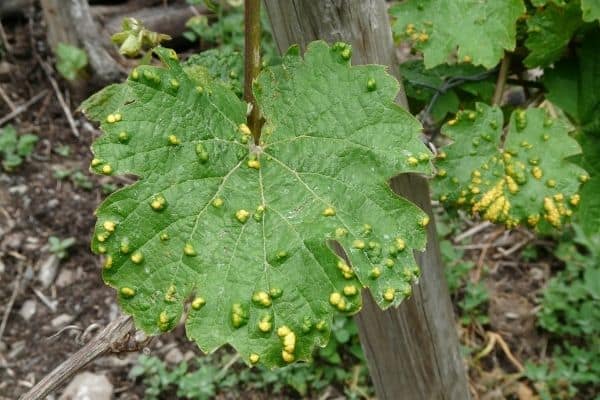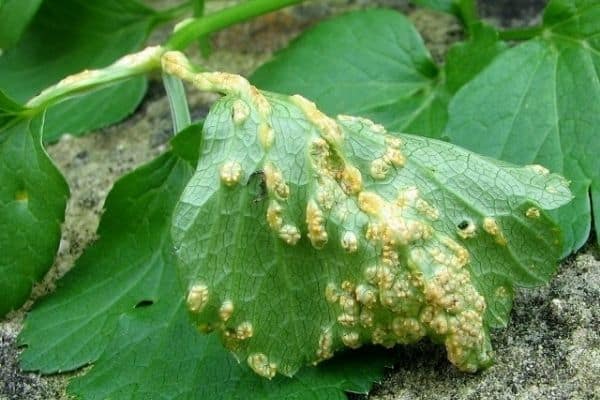
Plants can have all kinds of different diseases and pests which can sometimes be hard to identify. So I did a lot of research on the Cissus discolor and found out what the little lumps on the leaves of your plant might be.
The little lumps on your Cissus discolor can be insect or mite galls; which can be treated with a soap/water mixture. It can also be a fungus infection that can be treated with a fungicide or it can be edema which is a plant disorder that can be treated by giving the plant less water and the right kind of fertilizer.
In most cases, the little lumps on your plant will not harm the plant. But it is not aesthetically pleasing. This article will teach you exactly how to get rid of them!
Featured image by: Diego Delso
Contents
What are the little lumps on the leaves?
There are actually a couple of things that the lumps could be. If you know what the lumps are, you can use the correct way to remove them. If you don't know what they are, you can try twenty different techniques and still fail.
In order for you to identify these little lumps, there are a couple of images below that you can compare your own plant with.

Center image by Evelyn Simak. Right image by Andrew Petrie, University of Toronto, Bugwood.org
So the plants in these images are obviously not the Cissus discolor. However, that doesn't matter, because these lumps look somewhat the same on every plant.
The lumps can either be insects or mite galls, these are very common on plants. The next thing that it could be is a fungus infection, which is also pretty common on plants. Lastly it could be edema (or oedema), this is a plant disorder where the roots take up more water than the plant needs.
After you have identified what the lumps are (or you think you have identified) you can try to treat the lumps.
Every possible cause of the little lumps (including how to get rid of them) will be further explained below.
Treating Insect or mite galls
Insect or mite galls are actually not bad for your plant unless your whole plant is covered in them, they do not harm your plant. But that doesn't make it more aesthetical. In fact, it can make your plant look sick and unhappy.

There are two ways that these lumps are created.
- The first way is when insects use the leaves of the plant to lay eggs in them. This will form a gall that is filled with food for the baby insect inside to grow.
- The second way is when insects or mites feed on the leaf. The salivary secretion that the insect leave on the leaves will increase the production of the growth on that leaf which will cause little lumps on the leaf.
If you want to make sure that the lumps on your leaves are insect or mite galls, cut the infected leaf of the plant and put it in a sealed container. Leave it there for 6 weeks, if nothing emerges after these 6 weeks, then it isn't an insect.
Treating insect and mite galls:
Once the galls have formed, it's too late for treatment. Spraying the plant with a pesticide will not be effective once the galls have already been formed, because the insects are inside the galls and if you spray the leaves you won't reach the inside of the gall.
A good and organic way to prevent these galls from forming on your plants is to regularly spray the plant with a pesticide before the insects and mites are active. This may depend on the place where you live. Most insects are active just before and in the summer.
You can easily make an effective pesticide containing 1 tsp of liquid dish soap, 4 tsp of neem oil, and 1 gallon of water. Or you can use a premade and organic pesticide with natural oils and water. Click here to check out this organic and easy-to-use pesticide.
If you like this type of content, check out: What Happens to Plants if Their Leaves are Covered with Vaseline?
Treating fungus

Image by Evelyn Simak
The next possible cause of the little lumps on your plant can be a fungus, which can actually harm your plant.
The fungus can be caused by either infected insects, soil, air, contact with other infected plants, water splashes, and infected seeds. But a fungus can also be spread by hand or other tools that have been in contact with a fungus.
Fungus in plants is not uncommon and it's best to treat the fungus right away to minimize stress and damage to the plant.
Here are three of the most effective ways to get rid of fungus on your plant:
- The first thing you can try when countering fungus on plants is to use neem oil. This oil is 100% organic and it has done wonders for my plants in the past. Neem oil is a very effective and safe way to combat fungus or other pests on your plant. If you have pure neem oil, you always want to dilute it with water. But, you can also buy a ready-to-use neem oil solution. Click here to check out my favorite neem oil product on Etsy.
- Make your own natural fungicide that will kill the fungus. For this method, you need a spray bottle, baking soda, soap, and water. Dissolve 1 teaspoon of baking in 1000ml water and add half a teaspoon of dishwashing soap. Now spray the plant from top till bottom with this solution and let it dry. Repeat if necessary but don't soak your plant because too much baking soda can stun the growth of your plant.
- Use a chemical fungicide. When you use this method, ALWAYS follow the instructions on the back of the bottle.
Treating edema

Image by Andrew Petrie, University of Toronto, Bugwood.org
Edema, or oedema, is a plant disorder in which the roots of the plant take in more water than the leaves can handle. This will result in too much pressure inside the leave, which will then lead to little lumps on the leaf.
This disorder is not a disease, pest, or fungus. It is often caused by overwatering the plant or using the wrong fertilizer.
These little lumps can make the leaf curl and in some cases, small eruptions can take place. The gall-like lumps will burst open.
Edema can be treated by the following methods:
- Because a plant with edema takes in more water than it can use, make sure that you don't overwater the plant;
- Improve air-circulation, which will reduce the humidity around the plant;
- Slowly, every two weeks, increase the amount of light the plant receives. More sunlight will boost the rate of photosynthesis in the plant, which means the plant uses more water and the edema will fade.
- Make sure you fertilize your plant and make sure that your re-pot your plant once every 1-2 years to give the plant fresh potting soil.



Leave a Reply